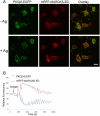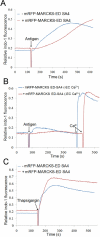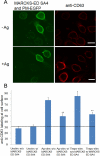Sequestration of phosphoinositides by mutated MARCKS effector domain inhibits stimulated Ca(2+) mobilization and degranulation in mast cells
- PMID: 22013076
- PMCID: PMC3237632
- DOI: 10.1091/mbc.E11-07-0614
Sequestration of phosphoinositides by mutated MARCKS effector domain inhibits stimulated Ca(2+) mobilization and degranulation in mast cells
Abstract
Protein kinase C β (PKCβ) participates in antigen-stimulated mast cell degranulation mediated by the high-affinity receptor for immunoglobulin E, FcεRI, but the molecular basis is unclear. We investigated the hypothesis that the polybasic effector domain (ED) of the abundant intracellular substrate for protein kinase C known as myristoylated alanine-rich protein kinase C substrate (MARCKS) sequesters phosphoinositides at the inner leaflet of the plasma membrane until MARCKS dissociates after phosphorylation by activated PKC. Real-time fluorescence imaging confirms synchronization between stimulated oscillations of intracellular Ca(2+) concentrations and oscillatory association of PKCβ-enhanced green fluorescent protein with the plasma membrane. Similarly, MARCKS-ED tagged with monomeric red fluorescent protein undergoes antigen-stimulated oscillatory dissociation and rebinding to the plasma membrane with a time course that is synchronized with reversible plasma membrane association of PKCβ. We find that MARCKS-ED dissociation is prevented by mutation of four serine residues that are potential sites of phosphorylation by PKC. Cells expressing this mutated MARCKS-ED SA4 show delayed onset of antigen-stimulated Ca(2+) mobilization and substantial inhibition of granule exocytosis. Stimulation of degranulation by thapsigargin, which bypasses inositol 1,4,5-trisphosphate production, is also substantially reduced in the presence of MARCKS-ED SA4, but store-operated Ca(2+) entry is not inhibited. These results show the capacity of MARCKS-ED to regulate granule exocytosis in a PKC-dependent manner, consistent with regulated sequestration of phosphoinositides that mediate granule fusion at the plasma membrane.
Figures






Similar articles
-
Functional involvement of protein kinase C-betaII and its substrate, myristoylated alanine-rich C-kinase substrate (MARCKS), in insulin-stimulated glucose transport in L6 rat skeletal muscle cells.Diabetologia. 2009 May;52(5):901-11. doi: 10.1007/s00125-009-1298-7. Epub 2009 Feb 28. Diabetologia. 2009. PMID: 19252893 Free PMC article.
-
MARCKS protein is phosphorylated and regulates calcium mobilization during human acrosomal exocytosis.PLoS One. 2013 May 21;8(5):e64551. doi: 10.1371/journal.pone.0064551. Print 2013. PLoS One. 2013. PMID: 23704996 Free PMC article.
-
Binding of myristoylated alanine-rich protein kinase C substrate to phosphoinositides attenuates the phosphorylation by protein kinase C.Arch Biochem Biophys. 1996 Feb 15;326(2):193-201. doi: 10.1006/abbi.1996.0065. Arch Biochem Biophys. 1996. PMID: 8611023
-
Phosphorylation of myristoylated alanine-rich C kinase substrate (MARCKS) protein is associated with bovine luteal oxytocin exocytosis.Biol Reprod. 2000 Jul;63(1):12-20. doi: 10.1095/biolreprod63.1.12. Biol Reprod. 2000. PMID: 10859236 Review.
-
Calmodulin and protein kinase C cross-talk: the MARCKS protein is an actin filament and plasma membrane cross-linking protein regulated by protein kinase C phosphorylation and by calmodulin.Ciba Found Symp. 1992;164:145-54; discussion 154-61. doi: 10.1002/9780470514207.ch10. Ciba Found Symp. 1992. PMID: 1395931 Review.
Cited by
-
The long noncoding RNA ROCKI regulates inflammatory gene expression.EMBO J. 2019 Apr 15;38(8):e100041. doi: 10.15252/embj.2018100041. Epub 2019 Mar 27. EMBO J. 2019. PMID: 30918008 Free PMC article.
-
Nanodomains in early and later phases of FcɛRI signalling.Essays Biochem. 2015;57:147-63. doi: 10.1042/bse0570147. Essays Biochem. 2015. PMID: 25658351 Free PMC article.
-
Cetylpyridinium chloride (CPC) reduces zebrafish mortality from influenza infection: Super-resolution microscopy reveals CPC interference with multiple protein interactions with phosphatidylinositol 4,5-bisphosphate in immune function.Toxicol Appl Pharmacol. 2022 Apr 1;440:115913. doi: 10.1016/j.taap.2022.115913. Epub 2022 Feb 9. Toxicol Appl Pharmacol. 2022. PMID: 35149080 Free PMC article.
-
Frontline Science: Tumor necrosis factor-α stimulation and priming of human neutrophil granule exocytosis.J Leukoc Biol. 2017 Jul;102(1):19-29. doi: 10.1189/jlb.3HI0716-293RR. Epub 2017 Jan 17. J Leukoc Biol. 2017. PMID: 28096297 Free PMC article.
-
Measurement of Exocytosis in Genetically Manipulated Mast Cells.Methods Mol Biol. 2021;2233:181-192. doi: 10.1007/978-1-0716-1044-2_12. Methods Mol Biol. 2021. PMID: 33222135
References
-
- Aderem A. The MARCKS brothers: a family of protein kinase C substrates. Cell. 1992;71:713–716. - PubMed
-
- Bai J, Tucker WC, Chapman ER. PIP2 increases the speed of response of synaptotagmin and steers its membrane-penetration activity toward the plasma membrane. Nat Struct Mol Biol. 2004;11:36–44. - PubMed
-
- Blackshear PJ. The MARCKS family of cellular protein kinase C substrates. J Biol Chem. 1993;268:1501–1504. - PubMed
-
- Blank U, Rivera J. The ins and outs of IgE-dependent mast-cell exocytosis. Trends Immunol. 2004;25:266–273. - PubMed
Publication types
MeSH terms
Substances
Grants and funding
LinkOut - more resources
Full Text Sources
Molecular Biology Databases
Miscellaneous

